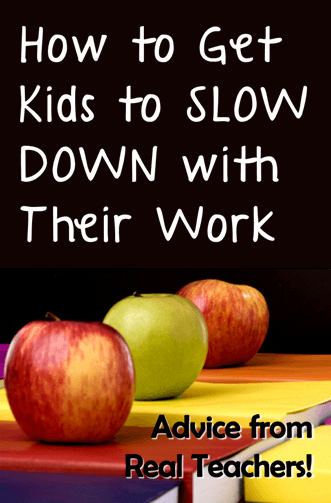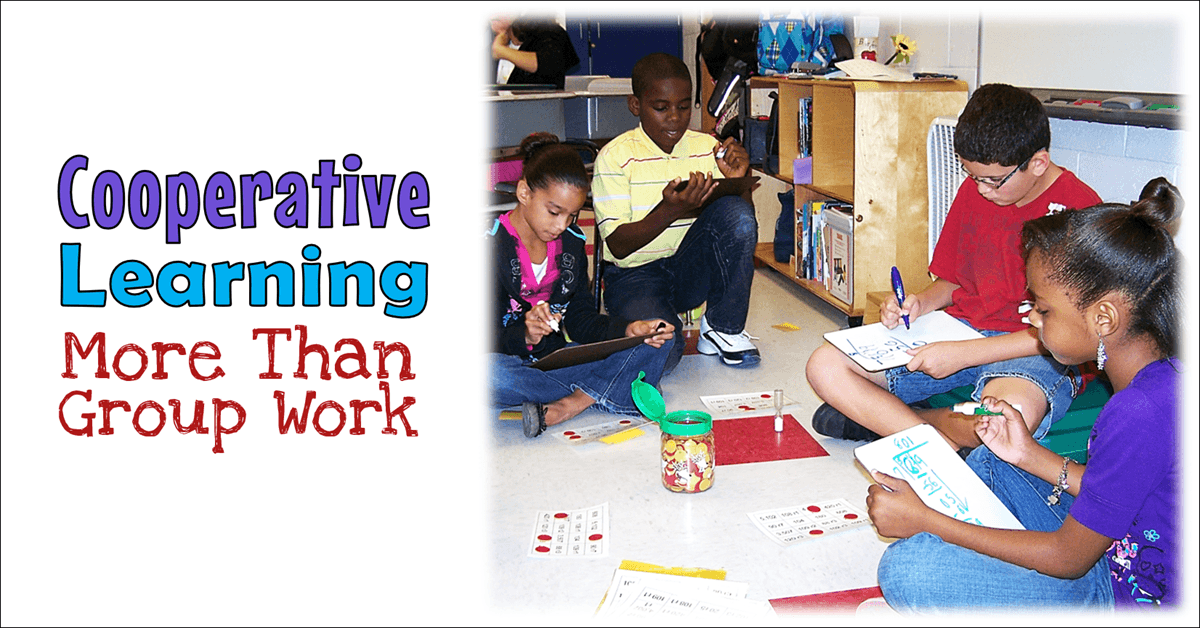Advice from Real Teachers
When it comes to encouraging kids to produce quality work, one of the biggest problems we face is getting kids to slow down and take their time. For some reason, students seem to feel there’s some sort of prize for the one who finishes first, or maybe it’s just that they want to rush through some assignments to get to other activities they think will be more fun. If this is something that you struggle with in your classroom, read on to learn 25 terrific tips from real teachers who have solved this problem.
Today’s Question
Every week on my Facebook page, I post the Question Connection where I invite teachers to ask questions, and I later share those questions with the fans. When I see that a question receives a lot of responses, I compile the best of them into a blog post.
Today’s teacher question comes from Cassandra who asks, “Can anyone share strategies for getting kids to slow down in their work? I feel like a lot my kids wanted to get things done as fast as possible and I struggled to motivate them to have pride in their work and take their time.”
Top 25 Tips for Getting Kids to Slow Down with Their Work
Apparently many teachers have a similar problem, and lots of terrific strategies were shared. I eliminated duplicates and narrowed the list to what I felt were the top 25 responses. This question was posted two different times, and if you would like to read the complete responses, you can click here and here.
-
- Gidget Greenlee – I always tell my students, “I would rather be the last A than the first F”.
- Casey McDaniel – 1) Explain how long you think the activity or assignment should take and why. Emphasize quality of work and expectations. 2) Have a turn-in tub “timer.” Don’t “open” the tub until you think the appropriate amount of time has passed. 3) Circulate around your classroom and keep an eye out for early finishers. Provide feedback and ask questions to help student dig deeper and put forth more effort. 4) Do speed conferences. Review early finishers’ work quickly and provide quick feedback verbally or on sticky notes to help students improve their work. 5) Always have follow-up tasks to assign to early finishers so they are never “done.” This should eliminate some of the rush to complete assignments and place value on quality.
- Cathy Vogler – I write them a “speeding ticket” and then put it in their planner for their parents to sign also. The student then has to do the work again during their free time at home and recess. I found the speeding tickets on TeachersPayTeachers.
- Emma Farrell – Sometimes if they know there is a fun activity at the end, they tend to rush. I like to use a star system that encourages students to work towards five star rated work. Come together as a class to decide on what that will be. Each criteria will be different for each lesson. Add things like, spelling, neatness, structure (for genre writing), tense etc.
- Lydia Wood – Have them write the time they start and time they finish on their paper. Give an example of how long a good paper should take. If they get a bad grade, you have proof of how long it took them
- Julie Lawson – I tell me first graders “it’s NOT a race ….(and they finish my sentence in unison ).. It’s a JOURNEY”. Then I finish with “enjoy your journey.”
- Paula Cull -You can set a timer and explain all you want, but they’re still going to rush through it. If I see one of my middle schoolers rushing through something, I collect their assignment when it’s finished and then give them another copy of the assignment and tell them that they will keep doing it until they do it correctly. It sounds harsh, but they need to realize that they need to do their assignments correctly.
- Trinity Tracy – Set a timer and project it. This shows them they still have plenty of time left. It also has the added bonus of getting stragglers to speed up!
- Judy Harrison – I have an under 70 % redo policy. That slows the speeders down, they hate having to redo work.
- Melanie Dorrian – “I want your best work, not your fastest work.” Say it like you mean it.
- Melanie Ketcham – Show them what an acceptable paper looks like and then show them what is not acceptable. Then stick to those standards and have rewards for those who follow your directions. (rewards could be to color, read, or play an academic game on the computer) The other students will soon follow your lead. They always want to please.
- Renee Von Wyl Kornish – With my sixth grade students, I set a timer for tests or activities that I wanted them to take special care in completing. They were not allowed to turn in their tests until after the timer went off. So, if they finished early they had to re-check their answers. I would walk around to observe that they were going back and re-checking. Once they realize that I won’t take their paper early anyway, there is no reason to rush.
- Alex Javoian – Post exemplar model pieces and a general rubric so they can “grade” their own work before turning it in.
- Virginia Nolland – I tell my kids to complete a section of work at a time then they must show me. If it’s not up to expectation, they have to complete that part again. As their work improves I stretch out the time they have to show me.
- Carie Rosa – This is a method used to help students do a good job on their work with a picture analogy. What you can do is take some pictures of you baking a cupcake in steps. The steps represent work turned in complete and not so complete just as you are baking a cupcake. You can take a picture of a perfectly finished cupcake and then make a sloppy one to take a pic of. Just show the difference and reference that to nice neat work. This year I will take four pictures and reference them to neat work. For example a plain non frosted cupcake, a perfectly frosted cupcake, a sloppy one and a burnt one.
- Natalie Wheeler – I send best work to the principal for praise.
- Tiffani Reed – We talk about and model quality work. What is quality work? How do you know? Show examples. Have the kids tell you what makes it quality work. Then only accept quality work from your students.
- CM Goodrich – Post a “Star” work poster displaying samples of great work, call it a club, and daily add new names as work improves. Also might try no cost rewards for good work product like entering name in jar to draw for biweekly eating lunch in room with teacher, etc.
- Joli Isip Scollo – Conference and give positive feedback and next steps (how to improve). Send them back to their seats to work on those next steps.
- Shelley Rolston – As crazy as this sounds, the best strategy I had this year after sharing and promoting others work was a happy face in their agenda ( next year it will be Class Dojo) for effort and neat work. I spoke to the parents ahead of time and they worked out an incentive at home for the child’s goal. (Ex 4/5 happy faces) It worked MIRACLES for the five or so 2nd graders I had. I suspect it could be adapted for older kids. They have to want to care. For the rest of the class, sharing their work aloud and peer editing is very effective. In both cases you’ll notice it is almost solely out of the teacher’s hands which is where it needs to be.
- Daniel Osborne – At the beginning of the year I make a big deal of being proud of your work. I show different examples of my own work from college or grad school and ask them to describe what they see. I also show them examples of work from some of previous students that are not acceptable. They go through them and give me reasons why they were not acceptable. I also say on a near daily basis, “Be proud of your work. Do not turn in slop.” If I do get slop I make them redo it. Once they see I am serious I rarely have students redo work.
- Georgia Boethin – I don’t let students get up to turn their work in when they are finished. They are to keep working or read if they get finished until I give them a signal that they have about a minute or two left to complete work. I then ask them to pass their work to the east or west and then north or south to a designated person. I teach them to place their paper face up with the top aligned as it should be on the next student’s desk. That student passes both of them on to the next and so on. All the papers are turned in at one time, and all of them are ready to just pick up and correct. It keeps the classroom orderly, and it avoids that rush to be done when someone gets up to turn in a paper. It’s very efficient. I teach fifth grade, so I don’t know if it would work with younger students, but I would think that it would.
- Angela Boykin-Schoppe – I make a LOT of comments praising quality work. What worked great with one of my boys (2nd grade) was letting him choose one assignment each day and do his very best. It was so beautiful that even his classmates noticed and complimented it on it. Before long–and it only took a week–the quality work was the norm. This probably wouldn’t work as well on older kids though.
- Laurel Quinn – I make a big deal out of quality student examples and what parts are to be celebrated. They go up on a star board. Rubrics are needed, too. I try not to accept rushed work. Keep making them redo, giving them pieces to focus on, and eventually after hundreds of eyeball rolls, they will hopefully try the first time.
- Sheila Quintana – I teach high school ELL. When my students tell me they’re finished, I just point to the “I’m finished” folder stapled to the wall. They can choose to check their work or grab an assignment out of the folder. 9 times out of 10 they choose to make their work better. Those that choose an extra assignment can have that assign
Thanks to everyone who offered such terrific tips! If you would like to submit a teacher question, be sure to watch for the announcement on Wednesday evenings at 8 pm EDT on the Teaching Resources Facebook page. Great Questions + Advice from Real Teachers = The Question Connection! Enjoy!







